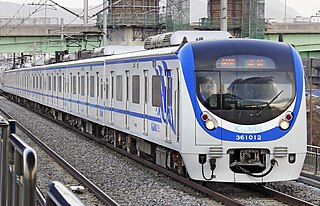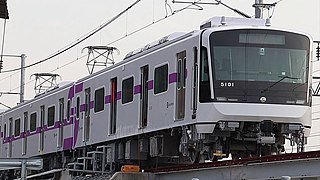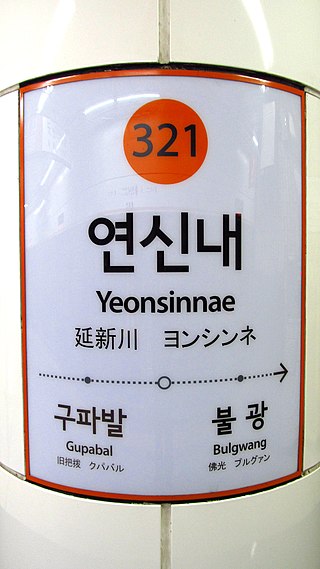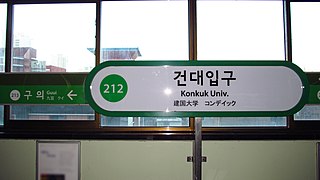
The Seoul Metropolitan Subway is a metropolitan railway system consisting of 23 rapid transit, light metro, commuter rail and people mover lines located in northwest South Korea. The system serves most of the Seoul Metropolitan Area including the Incheon metropolis and satellite cities in Gyeonggi province. Some regional lines in the network stretch out beyond the Seoul Metropolitan Area to rural areas in northern Chungnam province and western Gangwon Province, that lie over 100 km (62 mi) away from the capital.

The Gyeongchun Line is a regional rail line between Seoul and Chuncheon, South Korea, operated by Korail. Its name is derived from Gyeong and Chuncheon. It was completely reconstructed in the 2000s. Service on it has operated between Sangbong station on the Jungang Line in eastern Seoul and Chuncheon station, as part of the Seoul Metropolitan Subway system, since December 21, 2010. A class of regional rail service named ITX-Cheongchun began operations on February 28, 2012, linking Chuncheon to Cheongnyangni and Yongsan Stations.

Seoul Subway Line 5 of the Seoul Metropolitan Subway, dubbed the purple line, is a long line crossing from west to the east across the Seoul National Capital Area, South Korea. It is one of two subway lines in Seoul to cross under the Han River, which is done at two points. The main line runs through to Hanam Geomdansan Station while the branch line from Gangdong Station terminates at Macheon Station. In 2019, Line 5 carried an annual ridership of 334 million or about 915,000 passengers per day.

Seoul Subway Line 2, also known as the Circle Line, is a circular line of the Seoul Metropolitan Subway. The line running clockwise is called the "inner circle line" and the counter-clockwise line is called the "outer circle line". This is Seoul's most heavily used line, and consists of the main loop, the Seongsu Branch and the Sinjeong Branch for a total line length of 60.2 km (37.4 mi). The Line 2 loop is the third longest subway loop in the world after Moscow Metro Bolshaya Koltsevaya line and Beijing Subway Line 10. In 2019, Line 2 had an annual ridership of 812 million passengers or 2.2 million passengers per day.

Seoul Subway Line 3 of the Seoul Metropolitan Subway is a rapid transit service that connects Eunpyeong District to Gangnam and southeastern Seoul. Most trains head further northwest to serve Goyang via the Ilsan Line. In 2021, the Seoul Metro operated section had an annual ridership of 295,930,000 or 810,767 passengers per day.

Seoul Subway Line 7 of the Seoul Metropolitan Subway was built from 1990 to 1996 and was completed on August 1, 2000 ; the western section between Sinpung and Onsu was put into service on February 29, 2000. This north-south line does not run through the city centre but links Gangnam directly to the northeastern districts of Seoul. In 2019, Line 7 had an annual ridership of 380 million or 1.04 million passengers per day. Although most trains run between Jangam and Seongnam, some trains short turn at Onsu station and some trains start at Dobongsan station.

Seoul Subway Line 8 of the Seoul Metropolitan Subway was built from 1990 to 1999 and mainly serves the southeastern parts of Seoul and Seongnam. The first section from Jamsil to Moran opened in 1996, and the second section from Moran to Amsa was opened in July 1999. The line color is rose. In 2019, Line 8 had an annual ridership of 112 million or about 307,000 people per day. At 17.7 km (11.0 mi) in length, Line 8 is the shortest of all heavy rail Seoul Metropolitan Subway lines.

Seoul Metropolitan Rapid Transit Corporation (SMRT) was established in 1994 to operate the Seoul Subway lines 5, 6, 7, 8 in Seoul, South Korea.

Anguk station, also known as Hyundai E & C station (Korean: 현대건설), is a subway station on the Line 3 of the Seoul Metropolitan Subway. The station is located in the Anguk neighborhood of Jongno District, Seoul and is the nearest subway station to the Insa and Samcheong neighborhoods. The station is also near the ancient royal residence of Unhyeongung.

Gwanghwamun Station (Korean: 광화문역) is a station on the Seoul Subway Line 5 in South Korea. It is not the closest subway station to the actual gate of Gwanghwamun, which it is named after. It is located next to the U.S. Embassy in Seoul.

Yeongdeungpo District is an administrative district in southwest Seoul, South Korea. Although the origin of the name is uncertain, the first two syllables are thought to be from "yeongdeung" (靈登) or "divine ascent", a shamanic rite. The third syllable is "po", representing the bank of a river (浦), referring to the district's position on the Han River. The 2006 population was 408,819.

In Seoul, public transit buses are operated by the Seoul Metropolitan Government and private bus operators. The city maintains a quasi-public system where the city manages where the routes run, but private companies manage the running of the individual routes themselves.

Gwangjin District is one of the 25 districts of Seoul, South Korea. It is located on the north bank of the Han River on the eastern end of Seoul. The district was split from the neighboring Seongdong District in 1995. Gwangjin District is home to Konkuk University and Sejong University.

Yeonsinnae station is a station on Seoul Subway Line 3 and Seoul Subway Line 6, on the northwest side of Seoul in the urban area of Eunpyeong-gu. Although Yeonsinnae Station had a corresponding hanja name (延新內), this name was deemed incorrect and dropped in May 2001.

Jungnang District is one of the 25 gu, or districts, of Seoul, South Korea. It is located on the north side of the Han River.

Konkuk University Station is a rapid transit station on Seoul Subway Line 2 and Seoul Subway Line 7. It is located in Hwayang-dong in the Gwangjin-gu administrative district of Seoul. It is adjacent to Konkuk University from which it takes its name. Line 2 is serviced by an elevated platform while Line 7 is serviced by an underground platform. The station has connections to ten bus lines through its six exits as well as a connection to the airport shuttle bus. The station services Hwayang-dong as well as Jayang-dong and Noyu-dong. The area around the station is mixed residential and small commercial businesses. Exits from the underground Line 7 platform open into Konkuk University and the adjacent Star City shopping and high-rise residential tower complex.

Gyeongbokgung station (Korean: 경복궁역) is a subway station on Line 3 of the Seoul Metropolitan Subway. It is the subway station nearest to the Gyeongbokgung Palace. The station is also near the Government Complex–Seoul, the National Police Agency of South Korea, and other administrative buildings in the neighborhood.

Incheon Subway Line 2 is a driverless, medium-capacity subway line running 29.2 km (18.1 mi) from Oryu-dong in Seo-gu to Incheon Grand Park, with 27 stations, part of the Incheon Subway system. The line is also included as a part of the overall Seoul Metropolitan Subway network; Juan station has a free transfer with Seoul Subway Line 1, Geomam station connects with the AREX Line to Incheon International Airport and Seoul Station, and Seongnam also has a free transfer with Seoul Subway Line 7.
Seoul City in South Korea plans to build up to ten new light metro, or light rapid transit (LRT). They would be connected to the Seoul Metropolitan Subway giving access to several hundred subway stations. As opposed to traditional subway lines, LRT lines have a lower capacity.

Eungam is a station on Line 6 of the Seoul Metropolitan Subway. The station serves as the western terminus of Line 6 and is in the Yeokchon neighborhood of the Eunpyeong District of Seoul. Travel time between Eungam Station and Bonghwasan Station, the eastern terminus of Line 6, is approximately 57 minutes.




















